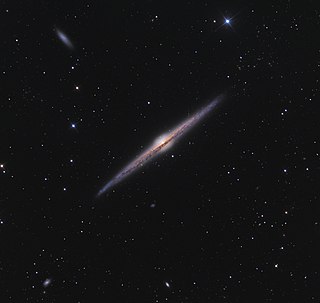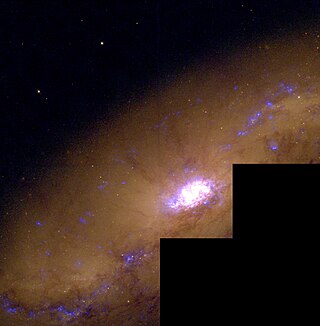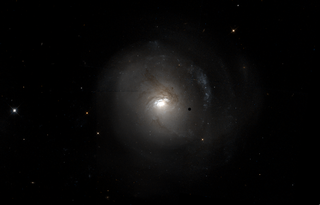
Messier 61 is an intermediate barred spiral galaxy in the Virgo Cluster of galaxies. It was first discovered by Barnaba Oriani on May 5, 1779, six days before Charles Messier discovered the same galaxy. Messier had observed it on the same night as Oriani but had mistaken it for a comet. Its distance has been estimated to be 45.61 million light years from the Milky Way Galaxy. It is a member of the M61 Group of galaxies, which is a member of the Virgo II Groups, a series of galaxies and galaxy clusters strung out from the southern edge of the Virgo Supercluster.

Centaurus A is a galaxy in the constellation of Centaurus. It was discovered in 1826 by Scottish astronomer James Dunlop from his home in Parramatta, in New South Wales, Australia. There is considerable debate in the literature regarding the galaxy's fundamental properties such as its Hubble type and distance. NGC 5128 is one of the closest radio galaxies to Earth, so its active galactic nucleus has been extensively studied by professional astronomers. The galaxy is also the fifth-brightest in the sky, making it an ideal amateur astronomy target. It is only visible from the southern hemisphere and low northern latitudes.

Messier 81 (also known as NGC 3031 or Bode's Galaxy) is a grand design spiral galaxy about 12 million light-years away in the constellation Ursa Major. It has a D25 isophotal diameter of 29.44 kiloparsecs (96,000 light-years). Because of its relative proximity to the Milky Way galaxy, large size, and active galactic nucleus (which harbors a 70 million M☉ supermassive black hole), Messier 81 has been studied extensively by professional astronomers. The galaxy's large size and relatively high brightness also makes it a popular target for amateur astronomers. In late February 2022, astronomers reported that M81 may be the source of FRB 20200120E, a repeating fast radio burst.

The Sombrero Galaxy is a peculiar galaxy of unclear classification in the constellation borders of Virgo and Corvus, being about 9.55 megaparsecs from the Milky Way galaxy. It is a member of the Virgo II Groups, a series of galaxies and galaxy clusters strung out from the southern edge of the Virgo Supercluster. It has an isophotal diameter of approximately 29.09 to 32.32 kiloparsecs, making it slightly bigger in size than the Milky Way.

Messier 95, also known as M95 or NGC 3351, is a barred spiral galaxy about 33 million light-years away in the zodiac constellation Leo. It was discovered by Pierre Méchain in 1781, and catalogued by compatriot Charles Messier four days later. In 2012 its most recent supernova was discovered.

Messier 108 is a barred spiral galaxy about 28 million light-years away from Earth in the northern constellation Ursa Major. It was discovered by Pierre Méchain in 1781 or 1782. From the Earth, this galaxy is seen almost edge-on.

NGC 6946, sometimes referred to as the Fireworks Galaxy, is a face-on intermediate spiral galaxy with a small bright nucleus, whose location in the sky straddles the boundary between the northern constellations of Cepheus and Cygnus. Its distance from Earth is about 25.2 million light-years or 7.72 megaparsecs, similar to the distance of M101 in the constellation Ursa Major. Both were once considered to be part of the Local Group, but are now known to be among the dozen bright spiral galaxies near the Milky Way but beyond the confines of the Local Group. NGC 6946 lies within the Virgo Supercluster.

NGC 7331, also known as Caldwell 30, is an unbarred spiral galaxy about 40 million light-years (12 Mpc) away in the constellation Pegasus. It was discovered by William Herschel in 1784. NGC 7331 is the brightest galaxy in the field of a visual grouping known as the NGC 7331 Group of galaxies. In fact, the other members of the group, NGC 7335, 7336, 7337 and 7340, lie far in the background at distances of approximately 300-350 million light years.

NGC 4565 is an edge-on spiral galaxy about 30 to 50 million light-years away in the constellation Coma Berenices. It lies close to the North Galactic Pole and has a visual magnitude of approximately 10. It is known as the Needle Galaxy for its narrow profile. First recorded in 1785 by William Herschel, it is a prominent example of an edge-on spiral galaxy.
The NGC 4631 Group is a poorly defined group of galaxies, about 25 million light-years from Earth in the Coma Berenices and Canes Venatici constellations.

NGC 1566, sometimes known as the Spanish Dancer, is an intermediate spiral galaxy in the constellation Dorado, positioned about 3.5° to the south of the star Gamma Doradus. It was discovered on May 28, 1826 by Scottish astronomer James Dunlop. At 10th magnitude, it requires a telescope to view. The distance to this galaxy remains elusive, with measurements ranging from 6 Mpc up to 21 Mpc.

NGC 1808 is a barred spiral galaxy located in the southern constellation of Columba, about two degrees to the south and east of Gamma Caeli. It was discovered by Scottish astronomer James Dunlop, who described it as a "faint nebula". The galaxy is a member of the NGC 1808 group, which is part of the larger Dorado Group.

NGC 3169 is a spiral galaxy about 75 million light years away in the constellation Sextans. It has the morphological classification SA(s)a pec, which indicates this is a pure, unbarred spiral galaxy with tightly-wound arms and peculiar features. There is an asymmetrical spiral arm and an extended halo around the galaxy. It is a member of the NGC 3166 Group of galaxies, which is a member of the Leo II Groups, a series of galaxies and galaxy clusters strung out from the right edge of the Virgo Supercluster.

NGC 2782 is a peculiar spiral galaxy that formed after a galaxy merger in the constellation Lynx. The galaxy lies 75 million light years away from Earth, which means, given its apparent dimensions, that NGC 2782 is approximately 100,000 light years across. NGC 2782 has an active galactic nucleus and it is a starburst and a type 1 Seyfert galaxy. NGC 2782 is mentioned in the Atlas of Peculiar Galaxies in the category galaxies with adjacent loops.

NGC 4647 is an intermediate spiral galaxy estimated to be around 63 million light-years away in the constellation of Virgo. It was discovered by astronomer William Herschel on March 15, 1784. NGC 4647 is listed along with Messier 60 as being part of a pair of galaxies called Arp 116; their designation in Halton Arp's Atlas of Peculiar Galaxies. The galaxy is located on the outskirts of the Virgo Cluster.

The Coma I Group is a group of galaxies located about 14.5 Mpc (47.3 Mly) away in the constellation Coma Berenices. The brightest member of the group is NGC 4725. The Coma I Group is rich in spiral galaxies while containing few elliptical and lenticular galaxies. Coma I lies in the foreground of the more distant Coma and Leo clusters and is located within the Virgo Supercluster.

NGC 3859 is a spiral galaxy located about 295 million light-years away in the constellation Leo. It was discovered by astronomer Édouard Stephan on March 23, 1884. The galaxy is a member of the Leo Cluster.

NGC 5965 is a spiral galaxy located in the constellation Draco. It is located at a distance of circa 150 million light years from Earth, which, given its apparent dimensions, means that NGC 5965 is about 260,000 light years across. It was discovered by William Herschel on May 5, 1788.

NGC 4302 is an edge-on spiral galaxy located about 55 million light-years away in the constellation Coma Berenices. It was discovered by astronomer William Herschel on April 8, 1784 and is a member of the Virgo Cluster.

NGC 1142 is a distorted spiral galaxy in the constellation of Cetus. It is located about 370 million light years away from Earth, which means, given its apparent dimensions, that NGC 1142 is approximately 170,000 light years across. It is a type 2 Seyfert galaxy. It interacts with the elliptical galaxy NGC 1141.




















